In analyzing a team's performance, it is important to touch on the positive and negative aspects of the process and identify areas of learning and improvement. The 4Ls retrospective template adequately addresses these topics collaboratively and constructively, making it the preferred evaluation tool many project managers use every time their team completes a task.
What is a 4 L's retrospective Template?
The 4Ls retrospective was designed by business systems specialists Mary Gorman and Ellen Gottesdiener as an evaluation tool for an agile project or any kind of team process.
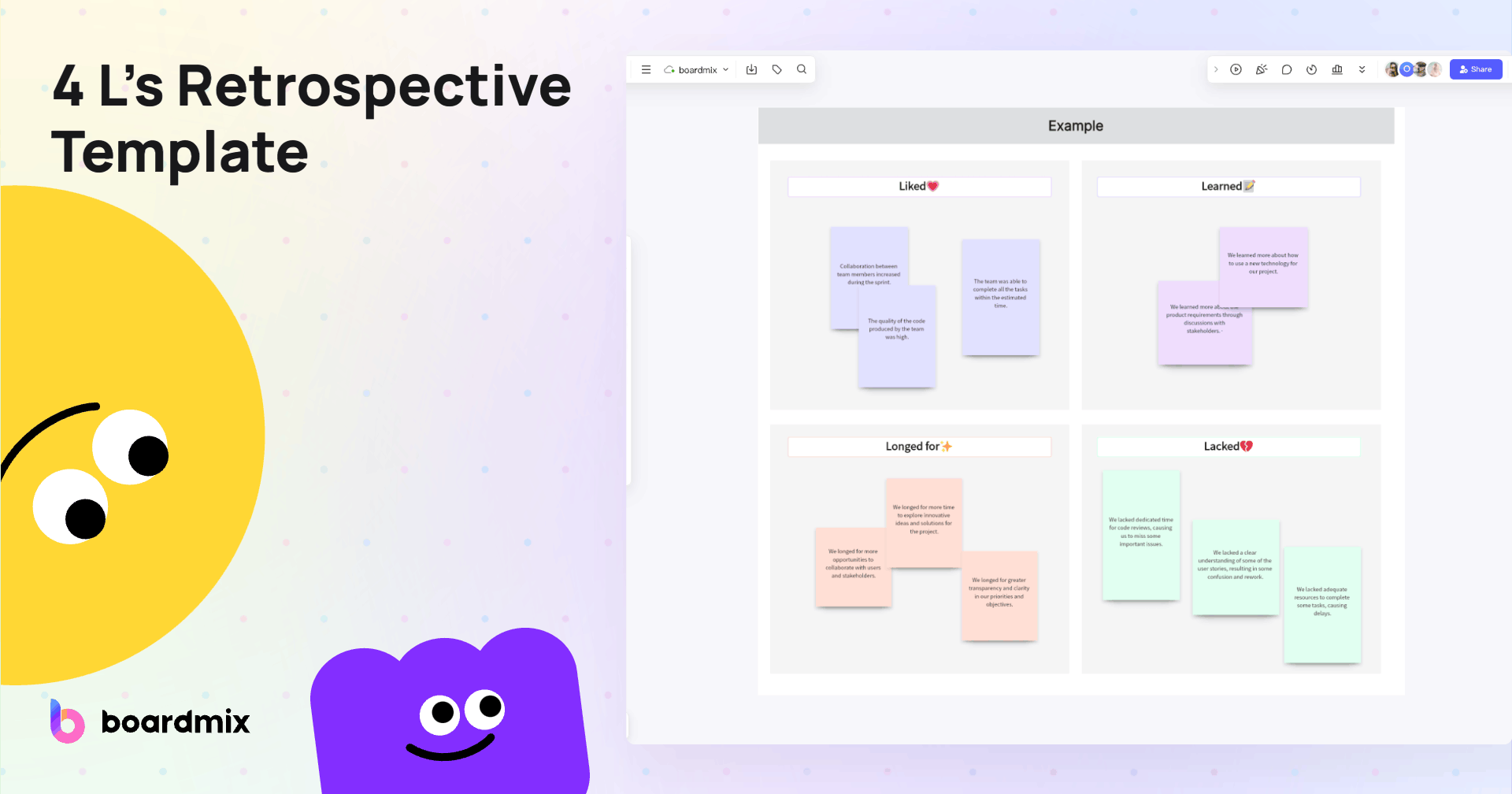
Build 4 L's Retrospective for Free
The 4Ls stand for Liked, Learned, Lacked, and Longed for. Each team member will share their thoughts on these four aspects during the retrospective. It is considered by many to be a great method for collecting feedback for evaluating performance and identifying areas for team growth.
What are the components of the 4L retrospective feedback technique?
The 4L retrospective feedback technique is a method that encourages open communication and continuous improvement within a team. It's composed of four key components: Loved, Learned, Lacked, and Longed for.
"Loved" refers to the aspects that team members appreciated during the project or sprint. This could be anything from effective communication to achieving set targets or even a particular team-building activity.
"Learned" focuses on the new knowledge or skills that were acquired during the process. This could be technical skills, project management strategies, or even personal growth insights.
"Lacked" is about identifying areas where the team fell short or could improve. It's important to foster an environment where these can be discussed openly and without judgment, as it's crucial for growth and development.
Finally, "Longed for" involves expressing what team members wished had been present or different in the project or sprint. This isn't about placing blame but rather identifying opportunities for future improvement.
By using this 4L technique, teams can effectively reflect on their performance and identify actionable steps toward continuous improvement.
Benefits of using a 4 L's retrospective
The 4Ls retrospective is significantly more objective than the other commonly used methods. It covers a broader range of project procedures, which is one of this technique's biggest benefits. Because it reaches further back into the earliest parts of the project, it allows the team to address more areas of improvement instead of just focusing on creating solutions to the more recent or more pressing issues.
Another benefit of the 4Ls retrospective is that it is very easy to implement. Unlike other methods that are quite complex and require a lot of effort to set up alone, this method is simple and easy to use, allowing for the fully engaged participation of all the team members.
When to use a 4 L's retrospective
Although many situations would benefit from a 4Ls retrospective, the best time to use it is when you have just finished a project that you expect to do again in the future in some form. You are looking for ways to improve your process without changing the whole thing.
Enhanced Team Communication: This retrospective encourages open dialogue among team members, promoting better understanding and collaboration.
Continuous Learning: By identifying what they've learned and what they lacked, teams can continuously learn from their experiences and improve their skills and knowledge.
Increased Engagement: The 4 L's retrospective engages all team members in the process of reflection and decision-making, leading to increased commitment and ownership of results.
Fosters Positive Attitude: This method focuses on positive aspects (Liked and Learned), which helps maintain a positive attitude within the team, even when discussing areas for improvement.
Action-Oriented: The insights gained from this retrospective can be directly translated into action plans for future work, making it a practical tool for improvement.
On the other hand, the same retrospective would also benefit a newly formed group or team. The feedback and insights from all the members can increase unity and make the team more cohesive, which is certainly good for future projects.
Application 4 L's Retrospective Templates
The 4 L's Retrospective is a powerful and versatile framework used to evaluate and enhance performance in various domains. Whether you're in software development, marketing, healthcare, or education, the 4 L's Retrospective can help your team celebrate successes, learn from experiences, address challenges, and envision new opportunities. Through this systematic reflection, teams can foster a culture of transparency, collaboration, and innovation, ultimately leading to enhanced productivity and job satisfaction.
1. 4 L's Retrospective for Marketing Teams

Build 4 L's Retrospective for Free
Loved:
- Successful Campaigns: Appreciated the creative freedom and success of recent marketing campaigns which exceeded targets.
- Team Collaboration: Valued the brainstorming sessions and cross-departmental collaboration that sparked innovative ideas.
- Customer Feedback: Enjoyed receiving positive feedback and engagement from customers, validating our strategies.
Learned:
- Market Trends: Learned about the latest market trends and customer preferences through data analytics.
- Content Marketing Strategies: Gained insights into effective content marketing strategies, including SEO and social media engagement.
- ROI Measurement: Improved understanding of measuring return on investment (ROI) for different marketing activities.
Lacked:
- Budget: Encountered constraints due to a limited marketing budget, affecting campaign reach and impact.
- Tools and Software: Needed more advanced tools for market research and campaign tracking.
- Time for Analysis: Lacked sufficient time for in-depth analysis and optimization of ongoing campaigns.
Longed For:
- Increased Budget: Desire for a larger marketing budget to expand reach and experiment with new channels.
- Advanced Analytics Tools: Wish for more advanced tools to better analyze customer data and campaign performance.
- Training Opportunities: Aspiration for more training opportunities to stay updated with the latest marketing techniques and tools.
2. 4 L's Retrospective for Education Teams
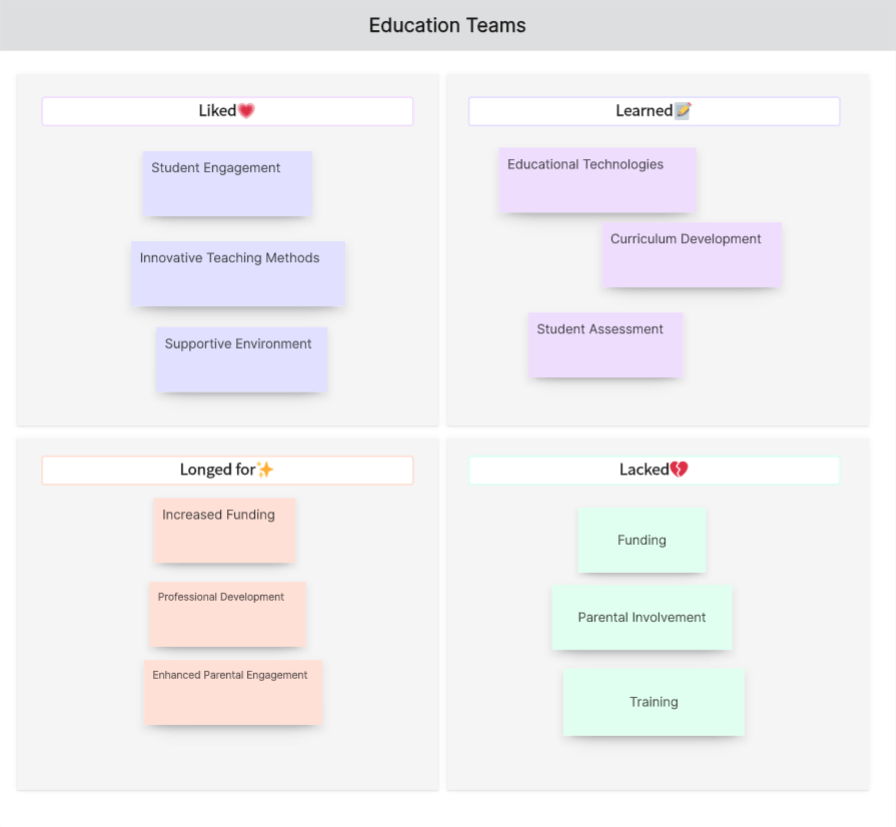
Loved:
- Student Engagement: Appreciated the high levels of student engagement and participation in classes.
- Innovative Teaching Methods: Enjoyed implementing and seeing the success of innovative teaching methods and technologies.
- Supportive Environment: Valued the supportive environment among staff and the collaborative culture.
Learned:
- Educational Technologies: Learned to effectively use educational technologies such as interactive whiteboards and learning management systems.
- Curriculum Development: Gained insights into developing and updating the curriculum to meet current educational standards.
- Student Assessment: Improved methods for assessing student performance and providing constructive feedback.
Lacked:
- Funding: Encountered challenges due to limited funding for new educational programs and resources.
- Training: More training opportunities for staff to stay current with educational trends and technologies.
- Parental Involvement: Lacked sufficient parental involvement and support in student learning processes.
Longed For:
- Increased Funding: Desire for more funding to support innovative programs and resources.
- Professional Development: Wish for more professional development opportunities for teachers and staff.
- Enhanced Parental Engagement: Aspiration for better strategies to involve parents in their children’s education and learning activities.
3. 4 L's Retrospective for Software Development Teams
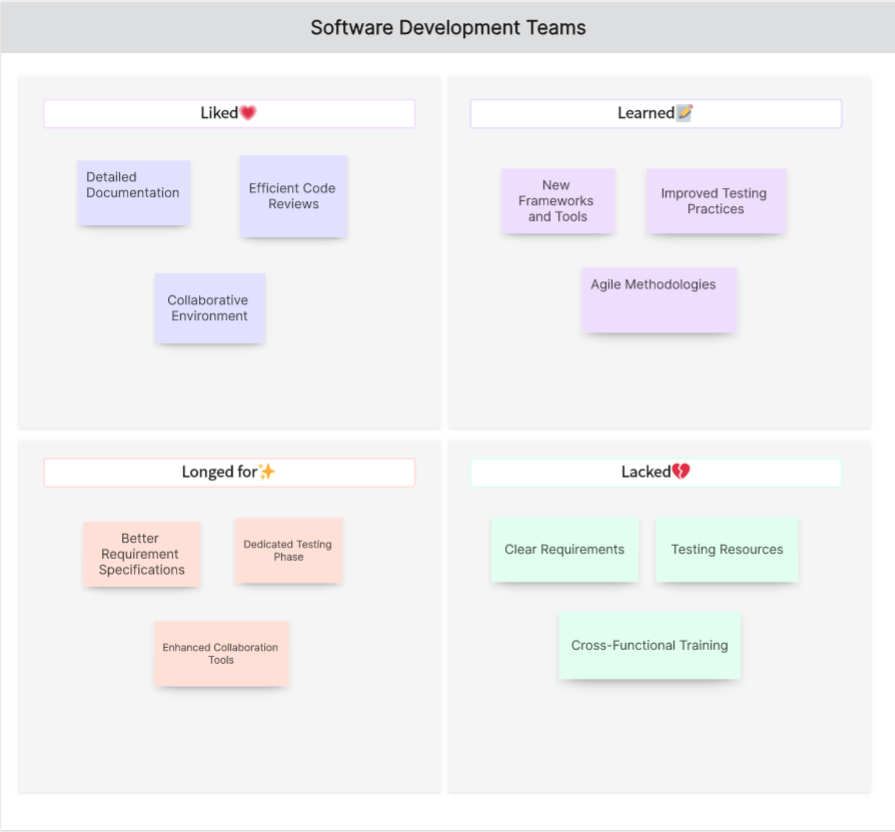
Build 4 L's Retrospective for Free
Loved:
- Detailed Documentation: Appreciated the comprehensive and up-to-date documentation provided for each sprint.
- Efficient Code Reviews: Enjoyed constructive and timely feedback during code reviews, which helped improve code quality.
- Collaborative Environment: Valued open communication and collaboration among team members, leading to innovative solutions.
Learned:
- New Frameworks and Tools: Gained proficiency in new frameworks and tools like Docker, Kubernetes, and React.
- Improved Testing Practices: Learned the importance of automated testing and continuous integration to catch bugs early.
- Agile Methodologies: Enhanced understanding of agile practices such as daily stand-ups, sprint planning, and retrospectives.
Lacked:
- Clear Requirements: Faced issues with vague or changing requirements which caused delays and rework.
- Testing Resources: Needed more resources and time allocated for thorough testing before deployment.
- Cross-Functional Training: Lacked opportunities for cross-training between front-end and back-end developers.
Longed For:
- Better Requirement Specifications: Desire for more detailed and stable requirement documents to minimize misunderstandings.
- Dedicated Testing Phase: Wish for a dedicated phase in the sprint solely for testing and quality assurance.
- Enhanced Collaboration Tools: Aspiration for better tools for collaboration and project management, like an upgraded Jira setup or integration with other tools.
How to Use Boardmix's 4 L's retrospective Template
Using Boardmix's 4 L's retrospective template is a simple yet effective way to encourage open communication and continuous improvement within your team. Here's a step-by-step guide on how you can utilize it:
Set Up the Boardmix Template: Begin by opening the 4L's template on Boardmix. The template should have four distinct sections corresponding to the four components: Loved, Learned, Lacked, and Longed for.
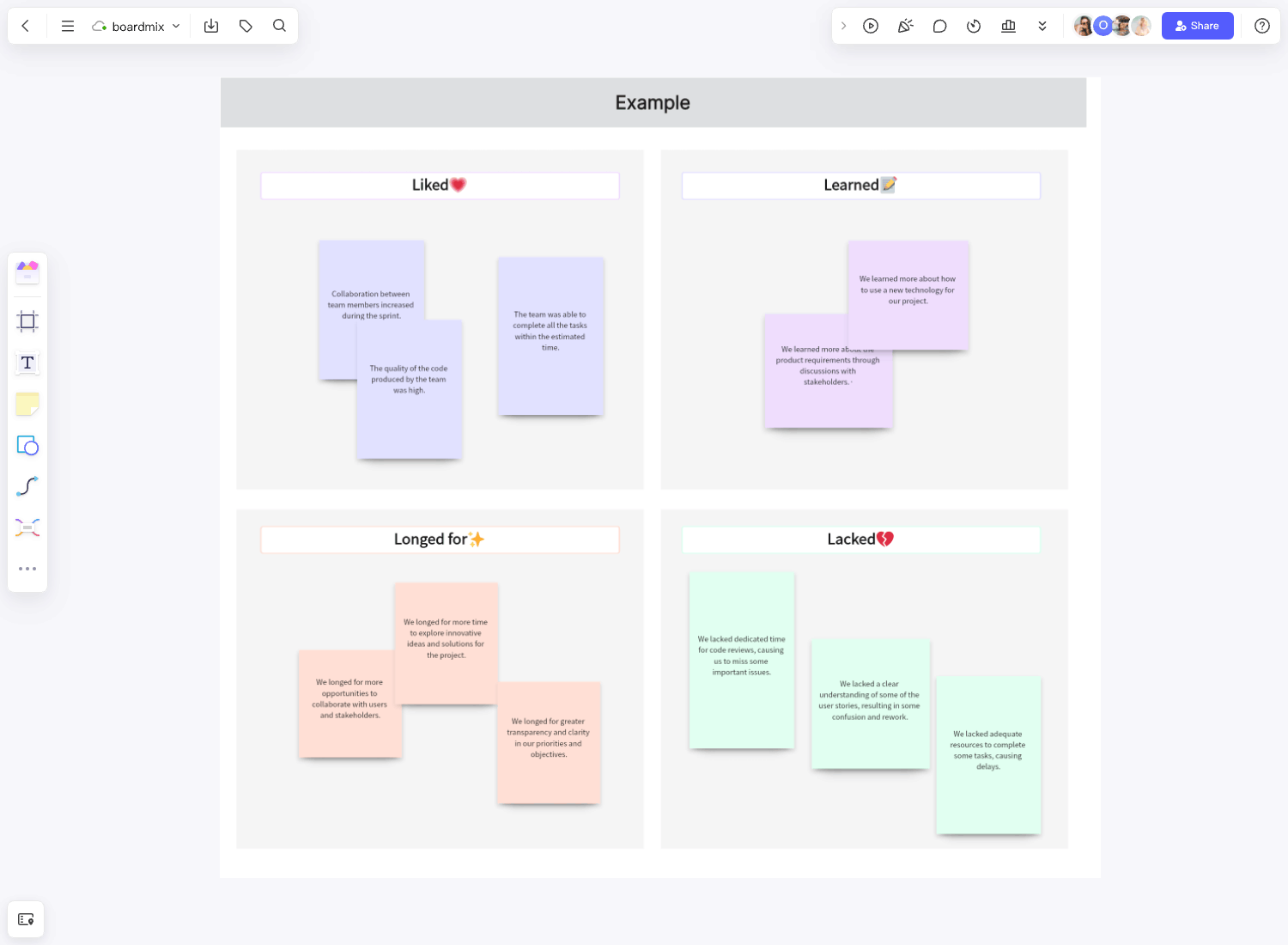
Build 4 L's Retrospective for Free
Explain the 4L's Technique: Make sure all team members understand what each of the 4 L's stands for and what kind of feedback they're expected to provide in each section. Encourage everyone to be honest, constructive, and respectful with their feedback.
Personal Reflection Time: Provide time for team members to individually reflect on the project or sprint and write down their thoughts under each category in the template. This step is essential as it allows everyone to consider their experiences without being influenced by others' opinions.
Collective Discussion: After everyone has filled out the template, initiate a group discussion where each member shares their inputs from each category. This should be a safe space where everyone feels at ease sharing their thoughts and experiences.
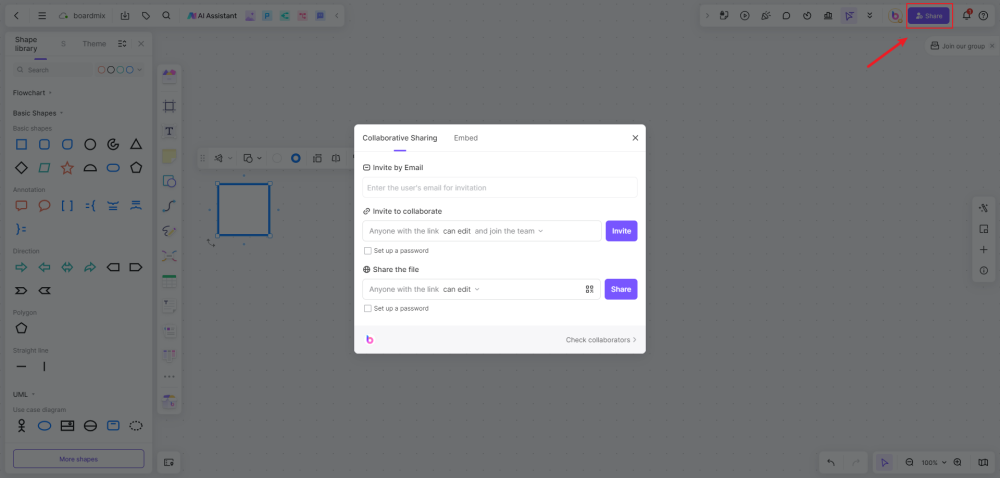
Identify Actionable Steps: Post-discussion, identify actionable steps that can be implemented based on the feedback received. This could involve introducing new strategies, allocating additional resources, or modifying certain processes.
Follow Through: Lastly, ensure that these actionable steps are tracked and followed through in upcoming projects or sprints. The aim of this retrospective is not just to identify areas of improvement but also to implement them effectively.
How to run a 4 L's retrospective
Doing a 4Ls retrospective traditionally using a regular whiteboard in the office is possible. But a much more efficient way is to do it online using Boardmix's 4 L's retrospective template. This way, the team members can be in different geographical locations or time zones, and you can still run the retrospective with everyone actively involved.
A great thing about the Boardmix template is that it is very easy to use. Just open it and share it electronically with your team. Everyone can add feedback for each of the 4 Ls using various tools available with the template.
In the Liked section, you will enter the good things about the project you liked. The Learned section would be for the lessons or realizations you had while working on the project. In the Lacked section, you can list everything missing, like a particular tool, insufficient time, and so on. Finally, the Longed for the section is for what you think the team should include or work on for the next project so that you can get an even better outcome.







